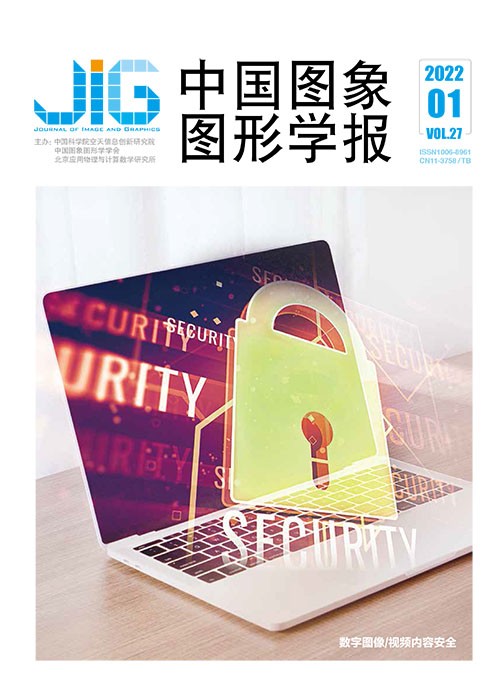
数字图像鲁棒隐写综述
张祎1,2,3, 罗向阳1,2,3, 王金伟4, 卢伟5, 杨春芳1,2,3, 刘粉林1,2,3(1.中国人民解放军战略支援部队信息工程大学, 郑州 450001;2.数学工程与先进计算国家重点实验室, 郑州 450001;3.河南省网络空间态势感知重点实验室, 郑州 450001;4.南京信息工程大学计算机与软件学院, 南京 210044;5.中山大学计算机学院, 广州 510006) 摘 要
随着智能设备和社交网络的飞速发展,通过网络传输的数字图像成为了实施隐蔽通信的新型重要载体,适应网络信道的图像隐写技术有望成为开放网络环境下可靠、隐蔽传递信息的一种重要方式。然而,数字图像通过Facebook、Twitter、微信、微博等社交网络传输的过程中,往往会遭受压缩、缩放、滤波等处理,对传统信息隐藏技术在兼顾鲁棒性与抗检测性方面提出了新的挑战。为此,研究者经过多年的努力探索,提出了可抵抗多种图像处理攻击和统计检测的新型鲁棒隐写技术。本文结合网络有损信道中隐蔽通信应用需求,对现有的数字图像鲁棒隐写技术进行综述。首先简要介绍本领域的研究背景,并从图像水印和隐写两方面对图像信息隐藏技术的基本概念、相关技术和发展趋势进行了简要总结。在此基础上,将图像鲁棒隐写技术的研究架构分为载体图像选择、鲁棒载体构造、嵌入代价度量、嵌入通道选择、信源/信道编码以及应用安全策略等方面,并分别对相关方法的基本原理进行了归纳和阐述。随后,对具有代表性的相关方法进行了对比测试,并结合应用场景需求给出了推荐的鲁棒隐写方法。最后,指出了数字图像鲁棒隐写技术有待进一步研究解决的问题。
关键词
Research progress on digital image robust steganography
Zhang Yi1,2,3, Luo Xiangyang1,2,3, Wang Jinwei4, Lu Wei5, Yang Chunfang1,2,3, Liu Fenlin1,2,3(1.PLA Strategic Support Force Information Engineering University, Zhengzhou 450001, China;2.State Key Laboratory of Mathematical Engineering and Advanced Computing, Zhengzhou 450001, China;3.Key Laboratory of Cyberspace Situation Awareness of Henan Province, Zhengzhou 450001, China;4.School of Computer and Software, Nanjing University of Information Science and Technology, Nanjing 210044, China;5.School of Computer Science and Engineering, Sun Yat-sen University, Guangzhou 510006, China) Abstract
Cyberspace security is intensively related to national security, national strategy and important policy guidance at present. Information content security is an essential part of cyberspace security. The issue of information prevention in context of illegal theft, tampering and destruction during network transmission has become a key aspect on national security and economic development. Image steganography is one of the hot research directions in the field of information security, which can embed secret message in the redundant part of digital images and transmit through open channels to realize safe and reliable covert communication, and has been widely used in national defense and civilian fields. With the rapid development of smart mobile devices and social network systems, digital images transmitted through open networks have become an important new carrier for covert communication, and the image steganography technology adapted to network channels is expected to become an important way of reliable and covert information transmission in open network environment. However, digital images are often subject to compression, scaling, filtering, etc. during the transmitting through social network systems such as Meta, Twitter, WeChat and Weibo, and existing information hiding technologies are often difficult to take both the robustness of embedded information and detection resistance of stego images into account. Hence, research on image robust steganography technology that can resist both multiple image processing attacks and statistical detection, and adapt to network lossy channels has important theoretical value and practical significance. After years of hard work, researchers have proposed new robust steganography technologies resisting multiple image processing attacks and statistical detection. Combining with the application requirements of covert communication in network lossy channels, this article reviews the current robust image steganography technologies. First, the related technologies and development trends of image information hiding technology are introduced from two aspects of image watermarking and steganography. For image watermarking technology, the typical robust watermarking algorithms based on image transformation and features are described separately, to discuss the theoretical and technical support that can provide to realize image robust steganography adapted to lossy channels. For image steganography technology, the typical adaptive steganography algorithms are introduced in both spatial and Joint Photographic Experts Group(JPEG) images, to mine the principle and idea of minimizing costs for message embedding. On this basis, the research framework of image robust steganography technology is divided into cover image selection, robust cover construction, embedding cost measurement, embedding channel selection, source/channel coding, and application security policies. Next, the basic principles of related robust steganography methods are summarized and explained from the above six aspects, such as the complexity-based cover image selection algorithm, robust cover construction algorithms based on coefficients relationship, side-information, and image features, embedding cost calculation algorithms utilizing distortion functions, embedding channel selecting algorithms considering image complex and smooth areas, message coding algorithms combining with error-correcting codes and minimizing cost codes, and application security strategy using data decomposition principle. Subsequently, comparative tests are carried out on the representative related methods in terms of robustness against multiple image processing attacks and detection resistance against statistical steganalysis features, and the recommended robust steganography methods are given based on the requirements of the application scenario. For example, if the target transmission channel only contains JPEG compression attacks, according to whether the compression parameters are known, the robust steganography algorithms based on coefficients relationship that resist multiple parameter JPEG compression attacks can be selected, or the robust steganography algorithms based on quantization step size and channel matching that have strong robustness and high reliability against specific parameter compression attacks can be utilized; if the target transmission channel contains multiple image processing attacks with unknown parameters such as compression and scaling, the robust steganography algorithm combined with Reed Solomon (RS) error correction coding that has strong error correction capability can be selected according to the requirements for communication reliability, or the robust steganography algorithm with strong error detection capability and combined with cyclic redundancy check (CRC) detection/error correction coding can be utilized for reliable covert communication. At last, some problems to be solved in the field of image robust steganography techniques are pointed out, in terms of accurate characterization of the influence of network lossy channels on stego sequence, virtual cover construction with multiple robustness and invisibility and so on. In general, the demand for covert communication in network lossy channels has brought new opportunities and challenges to image steganography, which contains many problems worthy of further research and exploration. Researchers need to make continuous efforts and gradually advance the process of image steganography from the laboratory to real life.
Keywords
information hiding lossy channel robust steganography image processing attacks statistical detection
|



 中国图象图形学报 │ 京ICP备05080539号-4 │ 本系统由
中国图象图形学报 │ 京ICP备05080539号-4 │ 本系统由